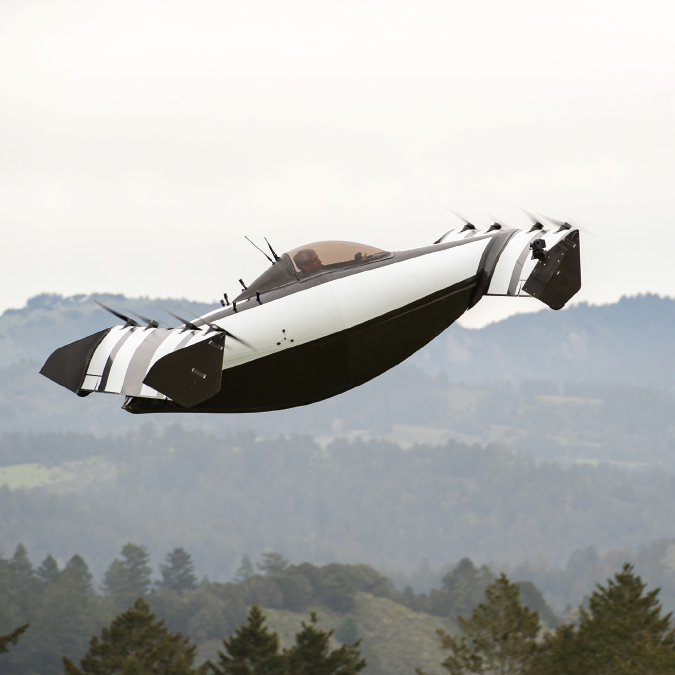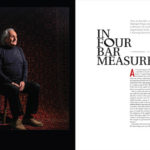
Sounds like something out of a sci-fi movie, but a Warkworth inventor turned Silicone Valley superstar is poised to unleash his brainchild on the buying public. You heard it here first.
IT WAS AN AUTUMN DAY IN 2011 WHEN MARCUS LENG AND HIS WIFE, EDWARDA, INVITED some friends and neighbours over to spend the afternoon on their 50 acres just southwest of Warkworth. It was a low-key gathering – just a handful of people – but they were there to witness something big. Marcus was about to show them the fruits of several years of his labour… something that had occupied all of his thoughts and consumed all of his time, not to mention a big chunk of his resources… something he had invented and refined until at last, it was ready for a public viewing.
It was, of all things, a prototype of a new kind of personal vehicle, a first attempt at a craft that defied description. Only slightly larger and wider than a car, it invited comparisons to an automobile because it was designed to be driven from Point A to Point B. But unlike a car, it didn’t need a road. In fact, it had no wheels. It was designed to fly, and although there was perhaps a passing resemblance to a glider, Marcus’ craft was propelled by eight very obvious rotors mounted on two tiers of wings. Nor was this a conventional airplane. It could be programmed to take off and land vertically, that is, without a runway. It could cruise at low altitude and hover and tilt, but before you compare it to a helicopter, know that it was not so cumbersome, far more compact and infinitely more energy-efficient.
Unlike most other forms of motorized transport, Marcus’ craft operated on electricity and, weighing in at just over a hundred kilograms, it didn’t consume nearly as much energy as you might guess. Moreover, it was more technologically advanced than you can imagine, with state-of-the-art electronics that, like an autonomous car, govern most of the navigation and piloting, greatly reducing the role of the driver, and likewise, driver error.
Some of the onlookers likened Marcus’ vehicle to a UFO. Some called it a kind of man-sized drone. For simplicity’s sake, perhaps the best way to describe it is to dig into the annals of science fiction, for what Marcus had constructed was no less than a 21st-century incarnation of a flying car: a real live household aircraft, the likes of which have been the stuff of sci-fi since the Wright Brothers made their very first flight at Kitty Hawk. With the savvy of an engineer and the creativity of an inventor, Marcus had developed an air-bound vehicle that was nimble enough to take off and land in the backyard; a craft that could potentially cruise to the office and back; a flying car that, with further refinement, Marcus hoped would make a significant dent in the role of the family sedan. Seems George Jetson’s atomic-powered air-rover was no longer futuristic fiction. It was being tested on Marcus Leng’s front lawn.
With his guests watching, cameras ready, Marcus strapped on a helmet and took his place in the cockpit. He advised everyone to give him a wide berth – in fact, he suggested they hide behind their cars, just in case everything went horribly wrong. He engaged the joystick. On cue, the electric motors kicked in, creating a mighty whoosh and a vigorous draft. The vehicle rocked from a resting position and rose about a metre off the ground. It hovered. Just as planned, it flew forward. It circled around at about 32 kilometres an hour.
As he brought the craft in for a landing, Marcus wondered if some of his guests would be disappointed. After all, it was all over in 20 seconds. It’s not like he had flown to Cobourg and come back with a bottle of champagne. But for Marcus, that wasn’t the point. After studying the aerodynamics, designing his prototype, crunching the algorithms and doing the math, he was finally seeing results. This thing could actually fly. It would go where it was supposed to. But as Marcus slowed to descend, his heart must have jumped when one of the wings scraped against the lawn. At speed, this could easily have spelled disaster for a lesser craft, but the prototype didn’t crash. Without any prompting from Marcus, it immediately righted itself and landed safely, just like it was programmed to do.
“That was the best lesson of all that day,” Marcus reflects. Not only had he built a working flying machine, the electronics had passed a major field test. And considering his plans to market his vehicle to the general public, Marcus knew that reliable and responsive electronics were just as important as aerodynamics, mechanicals and other aspects of design. Indeed, it’s the electronics that will be the critical factor in making Marcus’ invention fly in the marketplace.
TALKING WITH MARCUS IS LIKE HAVING A conversation with Henry Ford or Alexander Graham Bell. Definitely a man one step ahead of his time, he has an inventor’s mind, brimming with enthusiasm and bursting with ideas. Like those industry pioneers of another century, he is a born tinkerer who loves nothing more than crunching numbers, solving problems and hammering away at a theoretical concept until it can be put to practical use. But unlike Bell, who counted entirely on his father-in-law for business guidance, Marcus has proven himself a capable businessman, relying on his own wiles on an astonishing rise to the top. And unlike Ford, who couldn’t finance his horseless carriage without outside help, Marcus’ previous business achievements have left him with some pretty deep pockets enabling him to indulge his inventive ideas and bring them to reality. If anyone has the prerequisites to make a go of the flying car, it’s him.
MARCUS’ STORY BEGINS IN SCARBOROUGH, where he earned his pilot’s licence before he could drive a car. He studied mechanical engineering at U of T and, fresh out of school, he put his inventive mind to work in devising new applications for urethane foam. At his company called Multirim, he created a kind of memory foam that adapted well for use in office chairs and automotive seating. To this day, he credits a devotion to research and development for its success. In fact, Multirim did so well that he sold the company (it still exists) and retired at the tender age of 36.
“I had some things on my bucket list,” he says, recalling subsequent years spent as far away from the business world as he could get. He sailed to the Bahamas and called his boat home for the better part of the next 20 years. He married Edwarda. They built a home in the country – the Warkworth property – which they still own.
But like all inventors, Marcus eventually felt that old urge and soon found himself immersed in plans and projects.
It didn’t take long for Marcus to be picked up on the radar of the local Northumberland Community Futures Development Corporation (CFDC). Wendy Curtis, the executive director, was *literally* blown away when Marcus demonstrated the propulsion of the engine that would power his invention in his Warkworth basement. After she’d peeled herself off the wall, the CFDC group worked with Marcus, acting as a catalyst for next stages of the project’s development, setting up crucial contacts within Transport Canada – a relationship that is on-going – connecting him with industries and business leaders, even helping him set up “an obscure stealth laboratory” in the Spoolon factory on Division Street in Cobourg where Marcus could research and experiment in secrecy.
With the support of the CFDC and the backing of friends, family and business leaders, Marcus was able to surround himself with the right people: engineers with a thorough knowledge of aeronautics; new grads eager to experiment with propulsion systems; computer whizzes who understood the potential of drone technology; suppliers who could provide state-of-the-art components such as batteries and rotors.
Having returned to research after such a long absence, Marcus was impressed by the capacity of new lithium-polymer batteries which had been developed for model airplanes but were poised for more ambitious applications. He took note of the evolving technology in carbon-fibres – their light weight and superior strength had recently made them the darling of the aerospace industry. Likewise, Marcus was fascinated by advancements in electric motors. Who knew that a two-kilogram motor the size of a coconut could deliver so much power? Put it all together, he thought, and with the right calculations and the right electronics, he could build “something that could actually fly people.”
At first, Marcus questioned his figures, but the models confirmed his initial hunch. Then the light dawned. This could be a craft that could go well beyond a joyride in the sky. In an age where commuting times cost the economy dearly, it seemed the time was right for a vehicle that could circumvent a traffic jam. There had to be a market for a personalsized aircraft that could relieve the stress of the daily drive to the office. Marcus was confident that it could be commercially viable. Still, he wrestled with the idea, knowing that this would be a project even more consuming than Multirim ever was. He turned to Edwarda for advice. He recalls, “She asked me, ‘When you’re on your death bed, would you regret not pursuing this?’”
With that, Marcus was in business, perfecting what he refers to as his “personal aerial vehicle.”
Why not just call it a flying car? Marcus would tell you that no flying car has ever gone past the prototype phase, and for a number of reasons. For one, the research and development costs are enough to drain even the deepest corporate coffers. Worse, many of those early attempts produced vehicles that simply weren’t road- and/or airworthy. In 1926, Henry Ford himself scuttled plans for a “flying Flivver” after his pilot was killed in a test flight. More recently, in 1973, the same tragedy awaited the inventor of the AVE Mizar, a cumbersome car/plane assembly that mated a Ford Pinto to a Cessna airplane. As it approached the runway after a successful spin around the airfield, a wing buckled and the craft plummeted to the ground. It crashed in a fireball.
“Flying cars failed because they demanded too much of the user,” he says. But today’s electronics have changed that. Navigation systems can direct the vehicle to its destination. Sensors can monitor conditions and avoid collisions. With driverless cars on the horizon, autonomous flight isn’t a big leap. As one of Marcus’ partners notes, “I’ve noticed in my career that things go from the impossible to the inevitable in a very short period of time.”
A LOT HAS HAPPENED SINCE THAT FATEFUL afternoon in 2011 when he tested his aerial vehicle over his acreage in Warkworth. With eventual commercial production in mind, Marcus immediately dove into further refinement of the prototype.
In 2014, Marcus made the momentous decision to move his fledgling operation from Cobourg to Silicon Valley in northern California where it would be easier to recruit talent and like-minded suppliers were closer at hand. It was also a better place to attract investment: among the group who brought cash to the table were Larry Page, co-founder of Google, and Alan Eustace, the guy who parachuted from the stratosphere in 2014 and broke the altitude record. They called their start-up “Opener” and for several years, the enterprise worked under strict secrecy. “I didn’t want a word of this to leak out,” says Marcus, “until I was absolutely sure we had it right.”
After 20 incarnations of Marcus’ first prototype… after 20,000 test kilometres… and over a thousand flights (some in Saskatchewan), Opener is ready to market a single-seat, personal aviation vehicle to be known commercially as the “Blackfly” (what a Canadian name).
“We plan to have them on sale next year,” says Marcus. He estimates the Blackfly will cost about the same as an SUV. It will take off and land vertically within a target of one metre and will climb at more than 300 metres per minute. It can cruise at highway speed – albeit with a mere 40-kilometre range – between charges and with three back-up systems and state-of-the-art controls, including a “return-to-home” button, the electronics are said to be foolproof. If all else fails, there’s a parachute.
Nor will you need a pilot’s licence to operate it. Under federal regulations in both Canada and the U.S., the Blackfly is neither an airplane nor a car, but falls under the same policies as ultralight aircraft, those winged, open flyers that buzz through the sky in the summer. In the States, no licence is required at all, although special ultralight certification is required here in Canada.
Talk about an ambitious goal!
Currently, Marcus says there are about 50 other similar ventures in the works around the world and, much like the auto industry when it was in its infancy over a century ago, it’s anyone’s guess as to which will survive. Marcus is convinced the Blackfly has a real chance, because it’s the one with the most advanced electronics, and thus, is the easiest and safest to use.
He might be right. As word gets out, Blackfly is generating buzz within the aviation industry, where it is heralded as a major breakthrough. The press is over-the-top with enthusiasm, citing its intuitive controls and advanced electronics as Blackfly’s major advantages. Even the Smithsonian has taken note, requesting that Marcus’ prototype be added to its aviation collection, calling it the biggest advance of its kind in a generation.
Back home in Warkworth, we might wonder if the Canadian aspect of this story will be remembered, say, a hundred years from now. There’s something heartening in knowing that it was here in our very own Watershed country that, after a century of promise, the flying car finally got off the ground.
Story by:
Tom Cruickshank


